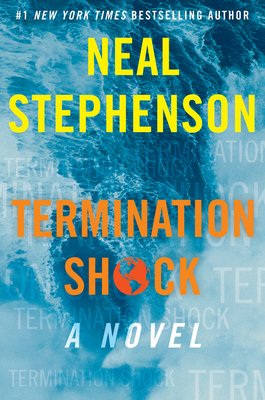SNQ: Neal Stephenson’s “Termination Shock”
by Miles Raymer

Note: In July 2022, I published an extended review of this book. You can check that out here.
Summary:
Neal Stephenson’s Termination Shock is a work of “cli-fi” (climate fiction) set in the near future, probably sometime in the 2040s. The book invites readers to imagine what might happen if someone unilaterally decided to initiate a solar geoengineering program to mitigate climate change. As rising global temperatures and sea levels make human life increasingly difficult, a billionaire in Texas decides to build a huge gun in the ground that fires bullets that release sulfur dioxide into the stratosphere. The story follows several characters who are either directly involved in or whose lives intersect with this project, depicting the challenges they face amidst rising geopolitical tensions about the implications and possible consequences of solar geoengineering.
Key Concepts and Notes:
- The book’s title has at least two meanings: (1) the technical definition of “Termination Shock,” which denotes the unknown environmental consequences that would result from an ongoing geoengineering project being suddenly shut down, and (2) the psychological shock of the world realizing that something serious is actually being done about climate change (the “termination” of the status quo). The story plays out under the penumbra of the former but spends most of its time exploring the dynamics of the latter.
- The book is both cheerfully optimistic and darkly cynical, depending on one’s point of view. This is a major strength because it makes the story highly interpretable, inviting spirited debate and deep analysis.
- Like all of Stephenson’s novels, readers will be treated to captivating tangents on a huge variety of near-future technologies. Here’s my list: drones (including ones with single passengers and automated flocking), earthsuits (modular clothing designed to help humans withstand extreme heat), augmented reality, artificial intelligence, solar geoengineering (grounded models as well as airborne), high-altitude conditioning and equipment, carbon-neutral air travel, “performative” war, non-lethal weapons such as EMPs, sea walls/sea level management, contact tracing apps, self-driving cars, artificial meat, cloud computing and climate modeling/prediction, disinformation delivered via social media (including deepfakes), underwater explosives that create targeted rogue waves, falconry as an anti-drone security measure, 3D printing, enhanced perception/proprioception as part of recovery from brain injury (transhumanism), carbon-neutral air and sea travel, 3D video surveillance.
- The story includes detailed examinations of the logistical challenges and ethics of climate change adaptation—it’s going to be a world of gray areas and trade-offs. Stephenson highlights the central importance of statistics/probability for dealing intelligently with climate change, noting how this type of stochastic thinking often comes into conflict with the psychology of narrative and tribalism.
- The characters in this novel are absolutely wonderful and have great development arcs, especially Rufus and Saskia.
- The book contains fun and very clever literary allusions to Moby-Dick, The Lord of the Rings, and The Iliad.
- We also get some novel interpretations of American history and colonialism, most notably the suggestion that the modern American ethos is most directly inherited from Comanche Natives.
- Some readers may feel that Stephenson gives rich and powerful people too much credit for acting as “saviors” to a bumbling humanity completely incapable of effective collective action. His penchant for elitism is conspicuously on display here.
- Arguably, the book’s biggest failing is its refusal to fully explore its eponymous concept; we never get to see Stephenson’s vision of what might actually happen if the Texas billionaire’s solar geoengineering experiment gets suddenly shut down. Similarly, the possible negative environmental side effects of solar geonengineering are either given short shrift or ignored entirely.
- This is the only novel I’ve ever finished reading and then immediately starting re-reading the next day. My first read-through convinced me that this is unquestionably Stephenson’s most important novel to date; my second read-through convinced me that it may also be his best.
Favorite Quotes:
There’s a man down in Houston who had the presence of mind, a few years ago, to put an axe in the world’s attic. We are here to find out whether the moment has arrived to pick it up. (93)
People can’t think statistically. People are hardwired to think in terms of narratives. (166)
You can’t solve such problems with local barriers. The politics are too…intractable. A planetary solution is the only way. (211)
Strange bedfellows have been a constant throughout all history. It’s just that climate change moves the beds around. (498)
It’s like, we’ve been in a car with a brick on the gas pedal and no one at the wheel, careening down the road, running over people and crashing into things. We’re still in the car. We can’t get out of the car. But someone could at least grab the wheel. T.R. ain’t the perfect man to grab it, but…He’s trying to get a global system up and running. Criticize it if you want. But I don’t mind helping when an opportunity presents itself. (655)